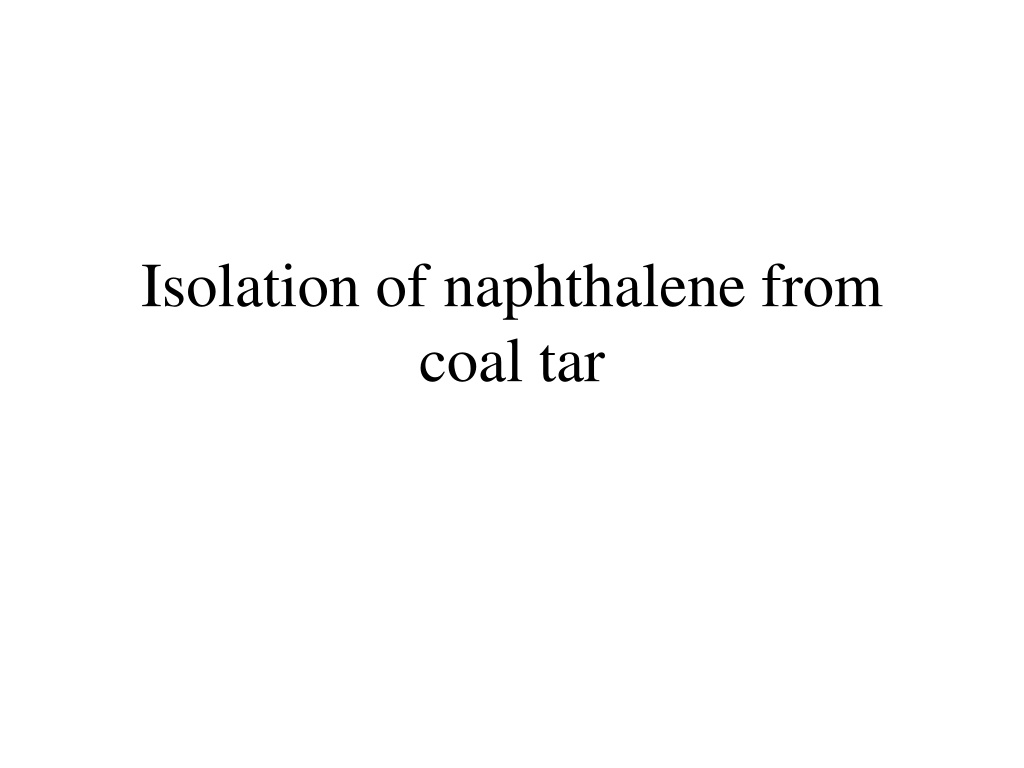Understanding Naphthalene: Properties and Production
Naphthalene, derived from coal tar or petroleum, is a key compound used in various industries. Its isolation process involves distillation and purification steps to obtain high-purity naphthalene. With its distinct chemical and physical properties, naphthalene plays a significant role in industrial applications.
Download Presentation

Please find below an Image/Link to download the presentation.
The content on the website is provided AS IS for your information and personal use only. It may not be sold, licensed, or shared on other websites without obtaining consent from the author. Download presentation by click this link. If you encounter any issues during the download, it is possible that the publisher has removed the file from their server.
E N D
Presentation Transcript
Isolation of naphthalene from coal tar
Most naphthalene is derived from coal tar. From the 1960s until the 1990s, significant amounts of naphthalene heavy petroleum fractions during petroleum refining, but today petroleum- derived naphthalene represents only a minor component of naphthalene production. Naphthalene is the most abundant single component of coal tar. Although the composition of coal tar varies with the coal from which it is produced, typical coal tar is about 10% naphthalene practice, distillation of coal tar yields an oil containing about 50% naphthalene, along with twelve other aromatic compounds. This oil, after being washed with aqueous sodium hydroxide to remove various phenols), and with sulfuric acid to remove basic components, undergoes fractional distillation to isolate naphthalene. The crude naphthalene resulting from this process is about 95% naphthalene by weight. The chief impurities are the compound benzothiophene (< 2%), and methylnaphthalene (< 2%). Petroleum-derived naphthalene is usually purer than that derived from coal tar. Where required, crude naphthalene can be further purified by recrystallization from any of a variety of solvents, resulting in 99% naphthalene by weight, referred to as 80 C (melting point). Approximately 1.3M tons are produced annually. were also produced from by weight. In industrial acidic components (chiefly sulfur-containing indane (0.2%), aromatic (< 2%), indene
Physical properties In the early 1820s, two separate reports described a white solid with a pungent odor derived from the distillation of coal tar. A naphthalene molecule can be viewed as the fusion of a pair of benzene rings. (In organic chemistry, rings are fused if they share two or more atoms.) As such, naphthalene is classified as a benzenoid polycyclic aromatic hydrocarbon (PAH). The eight carbons that are not shared by the two rings carry one hydrogen atom each. For purpose of the standard IUPAC nomenclature of derived compounds, those eight atoms are numbered 1 through 8 in sequence around the perimeter of the molecule, starting with a carbon adjacent to a shared one.
The chemical (molecular) formula of naphthalene is pretty easy to remember. It's simply: C10H8 The C stands for carbon and the H stands for hydrogen. As such, naphthalene is a hydrocarbon since it's composed of hydrogen ('hydro-') and carbon. Its chemical structure is actually really cool.
A naphthalene molecule can be viewed as the fusion of a pair of benzene rings. (In organic chemistry, rings are fused if they share two or more atoms.) As such, naphthalene is classified as a benzenoid polycyclic aromatic hydrocarbon (PAH). eight carbons that are not shared by the two rings carry one hydrogen atom each. standard IUPAC nomenclature of derived compounds, those eight atoms are numbered 1 through 8 in sequence around the perimeter of the molecule, starting with a carbon adjacent to a shared one. The shared carbons are labeled 4a (between 4 and 5) and 8a (between 8 and 1). For purpose of the























